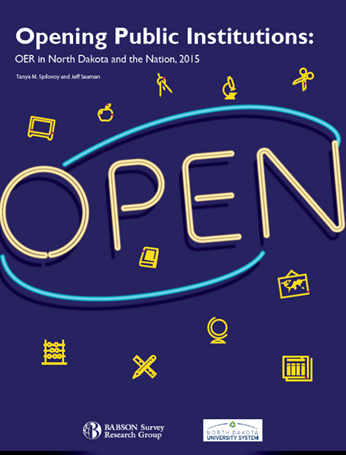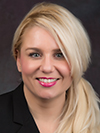North Dakota Open Educational Resources Initiative: A System-wide Success Story
Published by: WCET | 8/23/2016
Tags: Cost Of Instruction, Open Educational Resources, Textbooks
Published by: WCET | 8/23/2016
Tags: Cost Of Instruction, Open Educational Resources, Textbooks
The North Dakota University System Open Educational Resources Initiative is a 3-phased plan hinging upon a unique collaboration among the North Dakota legislature, the University System Office, and the faculty at public institutions across the state. At the intersection of these three entities are change leaders who have come together for a common goal of improving higher education by reducing textbook costs for students. A 2015 post previewed this work, and this post outlines the plan, the people, and the product.
The American public has called for a change. Higher education is expensive and the national student debt load is collectively around $1.3 trillion. Lawmakers and educators in North Dakota are interested in ideas that might reduce the cost of attendance at ND public institutions. During the 63rd Legislative Session, Thomas Beadle, a young representative, sponsored a legislative study and resolution urging the North Dakota University System to increase the use of open textbooks as a way to cut costs for college students. In 2013, the Legislative council estimated that North Dakota students spent around $1,100 per year on textbooks. Rep. Beadle described how the idea came about:
“Going into the 2013 legislative session, I really wanted to focus on our students and how we can try to look at new ways of helping them. For years we have been talking about the growing levels of tuition and fees, but we hadn’t done anything that looked at the other costs associated with going to school. As a young, recent college grad, I remember how frustrating it was to have to buy hundreds of dollars’ worth of books each semester, and only be able to get a fraction of that cost back when I would try to sell them later on. I knew that the internet and technology was changing the game in how content was being delivered, but I hadn’t been seeing it on my campus, and knew that as a state we could do better.”

“In collaboration with some friends of mine, who had faced very similar frustrations about rapid cost increases for books and ‘silent expenses’ that went in to their education, we came up with Open Textbooks as being a first step for North Dakota to look at in order to try and help the students of the state not only save a few dollars, but also to help them get a more active learning tool.”
“While I knew about Open Textbooks and the impact that they could have, the whole world of Open Educational Resources was very foreign to me. Fortunately, we had Dr. Spilovoy, a very visionary leader in the ND University System who would take our resolution pushing the NDUS to explore this new technology and run with it. When I introduced the concept, and got legislative approval, I had hoped to start a conversation and try to move the ball forward a little bit. I hadn’t expected the tremendous snowball effect that it would create!”
In order for a system-wide initiative to succeed, there had to be stakeholders involved at every level. A bipartisan and student-focused group of legislators on the Interim Higher Education Funding Committee supported the idea and provided a platform for innovation and feedback. The North Dakota University System put together a team made up of faculty, a student, technologists, and provosts to draft a white paper exploring the concept of open textbooks in response to the legislative request. Because I work with Academic Affairs and Technology at the NDUS system office, I was on the team that wrote the white paper. And after the legislative session, I was asked to lead the Open Educational Resources Initiative for NDUS. Over the next few months, I spent a significant amount of time researching, planning, and preparing presentations, and collaborating with stakeholders across the North Dakota University System.
Governance, cost, collaboration and policy considerations were paramount to the planning process. I wanted to find and partner with a repository of open education materials instead of having to create and maintain a library. The University System is built on the concept of academic freedom. Faculty own the curriculum and choose materials for the courses they teach. I knew that faculty development, support and buy-in were key to the success of the project. An effective approach would be to empower campuses to create and implement open educational resources and textbooks in a way that best suited their unique mission, vision, and faculty. Finally, I knew that funding would be necessary and that the legislature would be interested in seeing a return on its investment. I put together a project concept and presented it at the Interim Higher Education Funding Committee.
Textbook costs create a financial burden on college students that can impact their academic success and their financial health. North Dakota University System students each pay an estimated average of $1,100 per year for academic course textbooks. Open textbooks and other open educational resources can help alleviate the burden of textbook costs and reduce the cost of attendance. Open textbooks are complete, real textbooks that are licensed to be freely used, edited, and distributed. Open educational resources include peer-reviewed videos, simulations, lesson plans, and many other openly licensed materials.
By replacing traditional textbooks with open textbooks and open educational resources, the cost of attendance would be reduced without impacting the budget of the college or university. And faculty would have the opportunity to adopt open textbooks and educational materials that they can edit to best meet the needs of their students.
Concept Overview: Implement a system-wide Open Educational Resources initiative throughout North Dakota University System in three phases:
The work between sessions set the stage for successful implementation. And in the 64th Legislative session, Representative Thomas Beadle introduced legislation to fund a project to increase the use of Open Educational Resources. The governor and legislature supported the project with funding even though overall budgets had been cut state-wide. The final budget appropriation was $110,000.
Of the legislative appropriation to support the Open Educational Resources Initiative, Rep Beadle said, “One of the benefits of a state like North Dakota, is that we are a small community. While that can be seen as a limitation by many, it has actually helped us experience rapid success. We are small enough to be nimble and adapt quickly. Every stakeholder knows that they need to work with others in order to get things done, and we need to develop and foster relationships to get things done well. We have really created a strong team atmosphere that is working together to push OER in North Dakota, and to make this a success for our students, our institutions, and our state. The buy-in and leadership we have seen on our campuses within the faculty has been tremendous, and the assistance provided by our University System office has been crucial. As a lawmaker who is responsible to the citizens and the taxpayers, being able to see the return on investment has been crucial. Knowing that we have the players and stakeholders all seeing benefits, and seeing ways that we can improve and operate more efficiently, has allowed us to be able to get legislative support for these initiatives, and hopefully to continue to provide that support in the future.”
In order to show progress, cost savings, and project success, I began working on baseline project data. In 2013, Babson Survey Group released “Opening the Curriculum: Educational Resources in U.S. Higher Education, 2014.” I contacted Dr. Jeff Seaman of Babson Survey Group and asked if we could collaborate on a survey report comparing ND’s baseline data to the national survey data. He responded positively, and by October, 2015, we released “Opening Public Institutions: OER in North Dakota and the Nation, 2015.”
Key findings from the report include:
The NDUS joined the Open Textbook Network and began collaborating with other partner institutions already implementing open educational resources projects. I assembled a NDUS OER Steering Committee made up of a student representative, faculty members from each institution type, a legislator, and national experts in open education. In October, 2015, I organized a system-wide Open Educational Resources Summit at Valley City State University. Provosts were asked to send campus OER leadership teams made up of innovative faculty, librarians, instructional designers, and open-minded individuals. David Ernst, Ph. D., the Director of the Center for Open Education and Executive Director of the Open Textbook Network spoke and conducted a faculty workshop on open education and the adoption of open textbooks. Faculty that reviewed an open textbook from the Open Textbook Library and wrote a peer review received a $250 stipend.
The NDUS Open Educational Resources Campus Grants Call for Proposals was announced. Campus teams left the NDUS Open Educational Resources Summit energized to create their own campus plans and submit for funding.
On March 4, 2016, the OER Steering Committee met to review campus OER project proposals and give feedback. The initial state investment was $110,000. The first four funded proposals include estimated student cost savings of more than $2 million for school year 2016-2017. Three of the campus projects will provide faculty stipends to revamp general education courses using open source materials and textbooks. One project at the University of North Dakota will make Robinson’s “The History of North Dakota” an open textbook. Another round of grant proposals is due in October, 2016 with four more $10,000 institutional grants anticipated.
The final financial impact of this initiative will be calculated at the end of the 2017 fiscal year. In the words of Senator Tim Flakoll, Chairman of the Senate Education Committee, “The Open Educational Resources Initiative could well go down in history as having the highest return on any higher education investment we’ve made in the last 25 years.”
___________________________________________________
The North Dakota University System seeks grant proposals that implement high-impact, collaborative projects in support of open education and reduced textbook costs for students.
Applications for any amount of funding up to $10,000 are welcome from North Dakota University stakeholders, including faculty, librarians, technologists, administrators, students, and bookstore staff. Projects must involve the creation, adaptation or innovative use of Open Educational Resources (OER), which are educational materials that are openly licensed to the public to freely use, adapt, and share.
Sustainable adoption of OER is a complex issue with many parts, including course redesign, open material reviews, technology support, curriculum mapping, and much more. Project proposals will be evaluated using a rubric that balances the following criteria to prioritize impact and collaboration:
Completed proposals should be no longer than three well-written pages and signed by the applicants and supervisors. The OER Steering Committee anticipates making 5-10 awards. Proposals are due 5 pm Monday, February 29, 2016. The NDUS OER Steering Committee will notify applicants by 5 pm Thursday, March 31, 2016.
___________________________________________________

Tanya M. Spilovoy, Ed. D.
Director, Distance Education and State Authorization
North Dakota University System
Tanya.spilovoy@ndus.edu
8 replies on “North Dakota Open Educational Resources Initiative: A System-wide Success Story”
[…] (or Not Doing) About State Authorization: 2014 Survey, OER Supported by North Dakota Legislators, North Dakota Open Educational Resources Initiative: A System-wide Success Story) related to my Open Educational Resources(OER) project in North Dakota. With a small investment […]
[…] campuses across the country. Similar initiatives have gained momentum in California, New York, North Dakota, Oregon and other […]
[…] textbook costs were estimated to be around $148 million in 2016. Other states, like Georgia, North Dakota, and Oregon, have seen significant student savings in the first year of implementation; Colorado […]
[…] to date, and builds on a strong track record of state-level programs. States including Georgiaand North Dakota have funded open textbook grant programs that have ultimately saved students more than ten times […]
[…] to date, and builds on a strong track record of state-level programs. States including Georgia and North Dakota have funded open textbook grant programs that have ultimately saved students more than ten times […]
[…] to date, and builds on a strong track record of state-level programs. States including Georgia and North Dakota have funded open textbook grant programs that have ultimately saved students more than ten times […]
[…] Program, the pilot builds on a track record of successful state-level programs from Georgia to North Dakota to […]
[…] as a solution was based on state OER initiatives like Open NYS, Affordable Learning Georgia, and North Dakota OER Initiative, which have achieved 10 to 20 times the return on investment (in terms of student textbook savings) […]